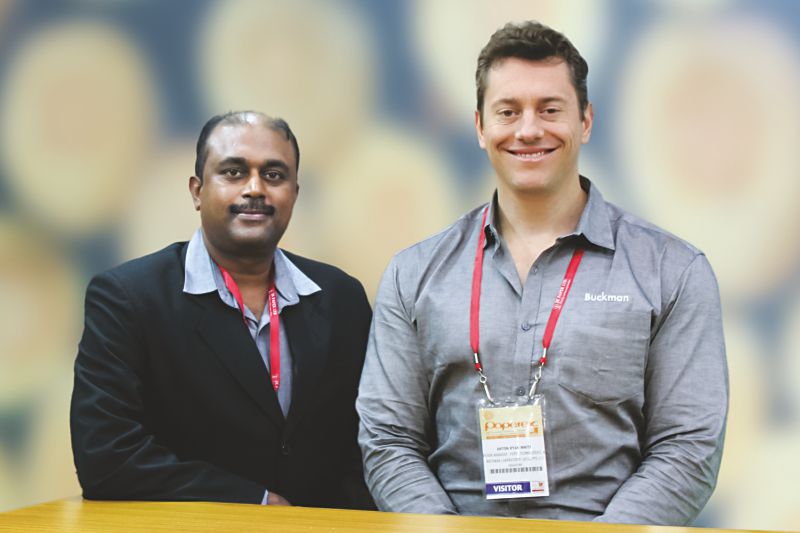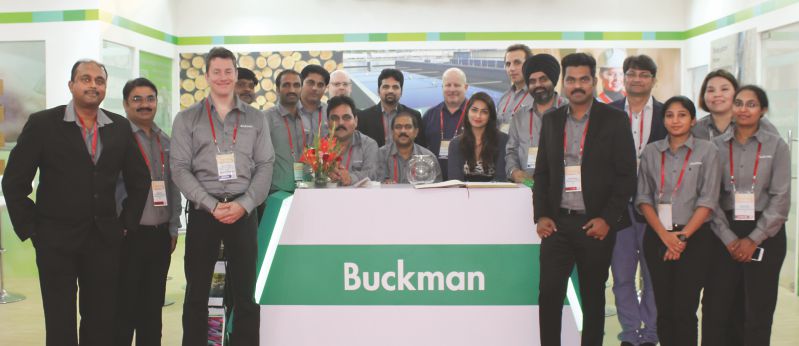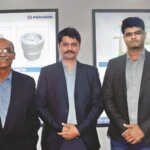Buckman, a pioneer in microbicides and enzymatic technologies for the paper industry, have given number of innovative solutions to the global pulp, paper and packaging industry across the entire manufacturing chain in addition to water treatment and recovery processes. The country’s Indian sojourn is satisfactory so far and it would like to go ahead with local manufacturing of some Indian-customized solutions.

Buckman, headquartered in Memphis, Tennessee, USA is a global specialty chemical company. The privately held company conducts business in over 90 countries, operating out of ten global locations – Memphis, TN; Cadet, MO; Canada, Europe, Mexico, Brazil, Australia, South Africa, Singapore, and China. The core industries that Buckman covers are pulp and paper, leather, and water treatment & process chemistry. Secondary industries include performance chemicals (paint, coatings, plastics, water formulators, wood treatment, and agriculture).
Paper Mart recently interviewed Mr. Anton White, Division Manager-Paper Technologies – Asia, Buckman and Mr. J. Kesava Ramanujam, Sales Manager-Paper Technologies, Buckman. Mr. White and Ramanujam explained how Buckman would go forward in India with its comprehensive range of solutions keeping Indian context of application and cost in mind. Excerpts:
Paper Mart: Please give us a brief introduction about the company and your role in it.
Anton White: Buckman is a 72-year-old company. It’s a family-owned company, which is still owned by the Buckman family. It was established originally by Dr. Stanley Buckman and up until the beginning of this year, it had been run by a Buckman family member. We recently named our fourth CEO, Junai Maharaj, who is the first non-Buckman CEO in the history of the company. Kathy Buckman Gibson, however, is the Chairman of the Board; so we still have a Buckman involved in the leadership of the business.

We started in the 1940s as the first company primarily involved in developing microbicides for the paper industry. The business evolved from there to a point where we have become a total solution and service provider to the industry, for example, anything in the wet-end – from microbicides and sizing chemistries to retention and drainage strength aids. Buckman’s chemistries for the paper industry encompass almost every component of papermaking, right from pulp street to finished paper. We have divided our paper market primarily into packaging, tissue, graphic paper, pulp, and utilities & water treatment.
Buckman has been a successful company so far, growing organically over the years. We are getting involved in some key IoT technologies as smart and digital growth of the business form a crucial part of our company’s strategy. That’s the way forward for our business – to be able to automate, use big data, and the internet of things.
As for my role, I am responsible for the Asian division of Paper Technologies for Buckman. All of the Asian countries except China, Japan, Australia, and New Zealand come under my supervision; Indonesia, India, South Korea, Thailand, Vietnam, Philippines, and Pakistan are some of the nations that I cover. Mr. Kesava Ramanujam is my manager for India and Bangladesh. He is the Regional Head for these two areas and has ample knowledge of the business and policies prevailing in the region.
Kesava Ramanujam: We now have taken the initiative towards smart technologies, especially IoT (Internet of Things), which is more important for the present generation as automation and smart data collection are going to be the key elements in driving and sustaining any business. Apart from smart technologies, we have Onsite® online monitoring systems and all other application programs to help improve mills productivity. These are some of the things which we have initiated at Buckman.
PM: Coming specifically to the product side, where does your chemical intervention come to the pulp and paper industry, and in what segments do you provide the chemical solutions to them?
AW: We have segmented our paper solutions business into five main categories, pulp, paper, tissue, packaging, and utilities & water treatment. We provide solutions right from the pulp mill – digester additives, cooking aids, pitch dispersants, brownstock washing deformers, etc. – to the final paper end products including wet-end chemistries, be it retention and drainage strength, functional additives, and defoamers.
On the tissue side – the creping aids and technologies, softeners, debonders, etc. Our solutions have helped optimize tissue absorbency, softness, and strength. In the packaging segment, solutions provided include improved sizing and retention-drainage chemistry to reduce total production cost; reduced steam consumption through wet-end and fabric management programs; reduced use of fiber through increased strength properties, etc.
For utilities & water treatment, we have grown to be a leading supplier of new-generation water treatment solutions for the pulp and paper industry, including influent and effluent treatment, water recovery and reuse processes (including liquid-solid separation, filtration, thermal, and membrane desalination), cooling and boiler water treatment, energy efficiencies to reduce your carbon footprint, process integrity, odor control, etc.
PM: As understood from the answer, Buckman’s chemistry is comprehensive and covers the pulp and paper industry almost entirely. The company must be engaged in continuous R&D to innovate ways and means to sustain in the chemical business, isn’t it?
AW: Around 15-20 percent of our sales are in products five years old or less. The point of the statement, from an R&D and product development perspective, is that we are always trying to drive new innovation, technology, and development. For example, we have done a lot of development work in enzymatic technology for bleaching called Vybrant® to improve the brightness in the pulp process We actually do have a reference in India of that technology. We are also in the process of developing products to enhance the oxygen delignification process in the pulp mills. We have a batch of new crepe aids specifically for structured tissue machines. We don’t really have much structured tissue in India, but it’s a very big and growing market in Europe and North America. Such product developments are ongoing and also a priority for industries like ours where product evolution is too fast and obsolescence sets in quite soon after a product is developed and used for a short period of time.
We do a lot of work with enzymatic technologies for fiber modification. In terms of new product development, we are in the process of developing new and smart technologies to enhance our chemical product offering. These digital technologies will help us track and monitor the application of our chemistries in order to deliver process and reliability optimization to the industries which are using our solutions. We have acquired a smart technology company called CiDRA Chemical Management Inc. (CCMI)1, which we will be using to do a lot of development work, especially in pulp mills and on paper machines.
PM: Apart from being an indispensable need for the pulp and paper industry, how does your chemical technology help the industry overcome the challenges regarding environment compliance, sustainability, and product quality?
AW: One of the biggest things for many industry player is sustainability. And being sustainable, by default, means environmental compliance. We often are asked about what our chemical solutions deliver in terms of ROI. There must be a reason why someone would choose to invest in a chemical product from us. Since our solutions are comprehensive and cover every stage of pulp and paper, there is consistency in both application and outcome, which enhances quality.
Beyond that, we like to talk about ROE which is Return on Environment and the amount of ROE that Buckman solutions can deliver for example, steam savings and a smaller water footprint. We have products that reduce the SOX and NOX from the burning of coal so that you get better combustion efficiency from the coal by reducing the actual emissions going to the environment. We have a carbon footprint calculator. When we go for an application, we try to establish what value and benefits you will get by applying this chemistry in terms of your environment footprint. And there is a process to calculate the carbon footprint related to those chemical applications – be it the water saving; be it the fact one is using a specific product to replace one that is less environmentally friendly; be it a chemistry that someone else is using and that would save you from having the environmental impacts because of your portfolio and your machines. Every case is different, but in every case, we do an environmental calculation on whether we are generating a return on the environment using Buckman Green Toolbox.
PM: Being a global player in chemicals, you have worked with many global companies in the pulp and paper industry, and you have also worked with the Indian companies. Do you find any difference in the reception of your technology in India and reception of your technology elsewhere?
AW: It is always interesting to compare the Indian market because India as a paper market looks like a giant market. However, it also tends to be a very fragmented market compared to other consolidated markets elsewhere on globe. The pulp and paper industry in India is fragmented into lots of smaller capacity mills with few large and medium size mills, and this fact of course affects the selection criteria of chemical applications by mills, depending on their mill size. A lot of the time, especially when it is a large functional chemistry, we compare ASA with AKD. Both are sizing chemicals. AKD, being a strong market in India, is a lot easier to apply on small, more isolated machines because it’s easier to pump compared to the size of an ASA system; applying ASA to a much smaller machine becomes very cost prohibitive.
Moreover, the Indian market in comparison to other markets is quite cost sensitive. The price negotiation or low-cost product requirement sometimes depends on where you are off-setting values (ROI/ROE). The price is more important sometimes, depending on the customer and depending on what their demand is. I can’t whitewash that; there are challenges on cost front. There are many segments of the market that are not all the same. However, the economy of scale is slowly happening here; we are gradually seeing bigger and bigger investments coming into the country. Historically, India’s economy of scale has been scattered with smaller investments; but, we have some nice big things going. So, getting those economies of scale which have been challenging in the past, is getting easier now as we are getting bigger penetration in those areas because of consolidation of the market.
PM: As you said Indian market is cost sensitive, which is true. How is Buckman positioned or gearing up to balance the cost, quality, and environment through your products?
AW: While I say Indian market is cost sensitive, it means it still needs to make that balance with regard to where I am in the world. To be honest, I still need to make that balance. That comes with identifying those key technologies I want to sell here and solutions where I know there are significant differentiation and value. That can be a true differentiator. Then you want to be able to at least leverage that value for the customer so that they can recognize and appreciate that value and see the benefit in their output, quality, efficiency, and environmental footprint. Whatever the expectation is in that regard, versus certain existing product lines (which have become more commoditized), I either enhance the efficiency through product development or look to local channels to market that allow us to have a more cost competitive advantage.
PM: How has the experience been with the customers so far in India?
AW: I think that also varies. With the larger cooperation, it’s often a lot of give and take. The recognition of value is increasing in India, I would say, probably because of the pressures from international markets. Besides, India is now able to compete in the global market because of becoming value oriented. There is a lot of stuff coming to India, especially from China. There are lots of companies, who want to export to Europe or other areas in order to compete. The recognition of value, or recognition of even technologies for improved automation, improved deficiency, improved data, is increasing in India from where it was in the past. I think India is becoming more recognized from that respect. The market has moved a lot from where it was a long time ago. Having said that, there is still the pressure on the industry in India from outside, creating a dichotomy where the Indian papermakers need that value, but they at the same time need to compete with a paper from outside having certain cost advantages. It’s a challenge to balance.
India had been a dynamic market, I would say, often because of the nature of the market. For example, the industry experienced water shortages in many of its mills, and operating rates went down suddenly, not because of the market but some uncontrollable extraneous factor. Other instances of such market hampering factors may be the incredible pressure in the tissue industry where foreign companies dump a lot of tissues into the market, Chinese companies or other South East Asian nations bringing printing and writing products which are lower in prices into the market, import of packaging boards, etc.
Some key progress we have made in certain sectors of the business, and which we had not yet applied to the Indian market. We have started to make market penetration in those areas this year and started to develop some credibility, which we will continue to do as we expand in the market. That has started to happen, which is quite exciting. From that perspective, I have been really happy with the performance this year in India.
PM: Can you tell me about the Indian presence of Buckman right now and the future expansion that is going to take place?
KR: Actually, when we started Buckman’s Indian entity about eight years back, we were present in some areas. Now, we are presenting almost everywhere, and we cover most of the major customers. Our main target now is to make more products available in India for our present customers and future prospects. Apart from this, we are bringing a new product portfolio, which is in the pipeline to be announced soon.
PM: Any final words you would like to add.
AW: I would like to highlight the importance of the Indian market in what we classify as part of the Asian market. Outside of China, you have got two big giants, i.e. India and Indonesia. South Korea is a big but kind of a no-investment market so far. The impressive thing to me about India, I would like to highlight, even though it tends to be on a smaller scale, there is investment going on all the time. There still seems to be a lot of dynamism around the Indian market despite it being hugely segmented. There is a lot of growth apparent in the Indian market, and that is exciting!



